Review of Energy Consumption by the Fish Farming and Processing Industry in Croatia and the Potential for Zero-Emissions Aquaculture
Abstract
1. Introduction
1.1. Environmental Impact of Fisheries
1.2. Technology Improvement
1.3. The Aim of the Paper
2. Methodology
2.1. Structure of Fish Farming and Processing
2.2. Energy Consumption in the Considered Phases
2.3. Implementation of Alternative Power Options
2.3.1. Alternative Power Options for the Vessel
- LCCA of diesel-powered ship
- LCCA of an electric-powered ship
- LCCA of an LNG-powered ship
- LCCA of a B20-powered ship
2.3.2. Alternative Power Options for the Fish Processing
2.3.3. Alternative Power Options for the Fish Distribution Process
3. Case Study
4. Results and Discussion
- The results were obtained by combining the input data taken from the relevant literature and some real data obtained from the producer, which require further justification (e.g., energy consumption in the fish factory). Therefore, sensitivity analyses of the results with respect to the selected input data are provided in the Appendix A.
5. Conclusions
Author Contributions
Funding
Conflicts of Interest
Appendix A
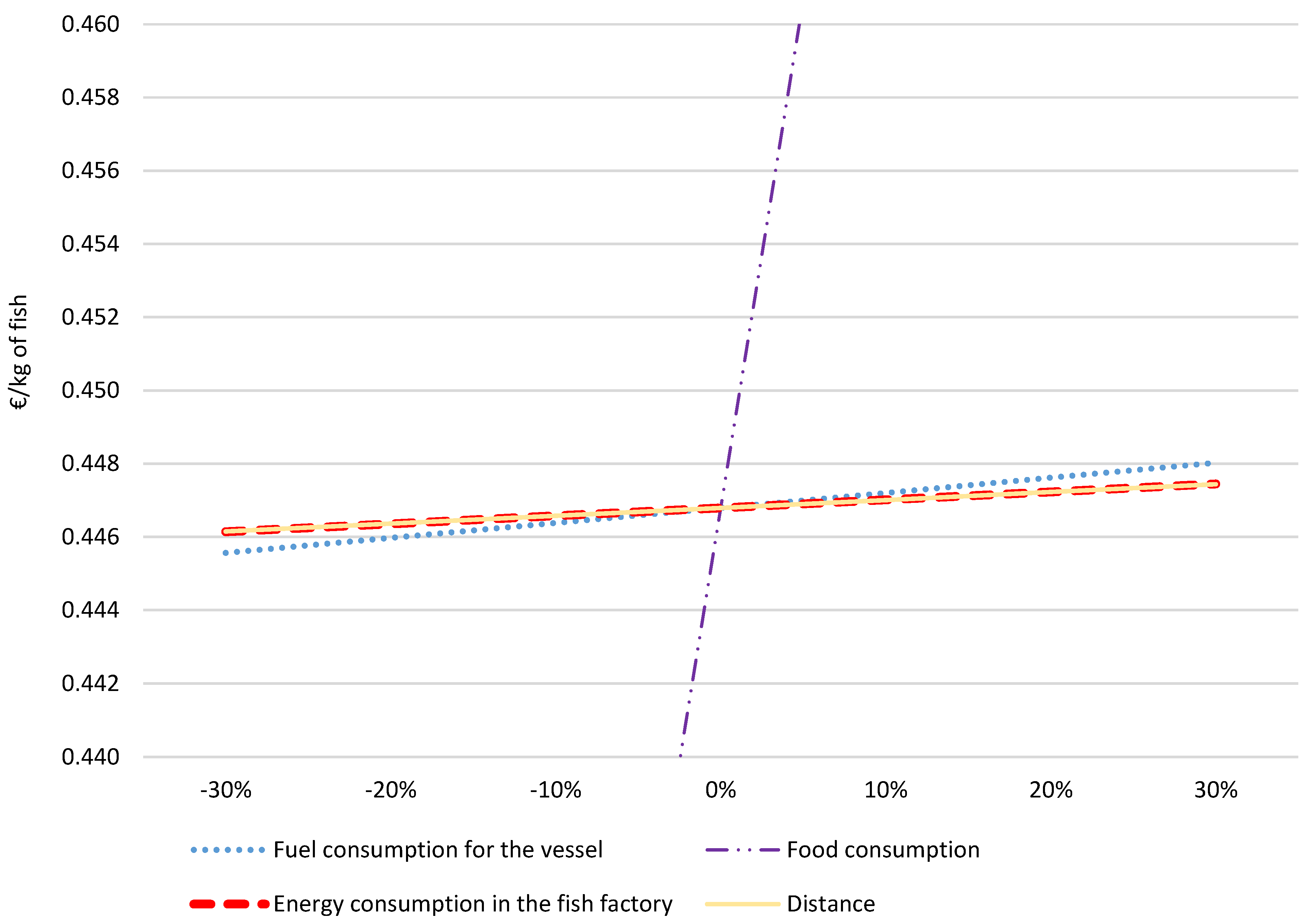
References
- Koričan, M.; Perčić, M.; Vladimir, N.; Soldo, V.; Jovanović, I. Environmental and Economic Assessment of Mariculture Systems Using a High Share of Renewable Energy Sources. J. Clean. Prod. 2022, 333, 130072. [Google Scholar] [CrossRef]
- Haramina, T. Studija o Utjecaju na Okoliš za Uzgajalište Bijele Morske ribe na Lokaciji Kraj Otoka Maun, Dvokut ECRO d.o.o. 2020. Available online: https://mingor.gov.hr/UserDocsImages/UPRAVA-ZA-PROCJENU-UTJECAJA-NA-OKOLIS-ODRZIVO-GOSPODARENJE-OTPADOM/Puo/07_12_2020_Studija_Uzgajaliste_bijele_ribe_Maun.pdf (accessed on 10 September 2022).
- Food and Agriculture Organization (FAO). FAO Yearbook. Fishery and Aquaculture Statistics 2019/FAO Annuaire. Statistiques des Pêches et de ’’Aquaculture 2019/FAO Anuario. Estadísticas de Pesca y Acuicultura 2019. Rome/Roma. 2021. Available online: https://www.fao.org/fishery/en/publications/287024 (accessed on 25 June 2022).
- Zhang, Y.Y.; Zhang, J.H.; Liang, Y.T.; Li, H.M.; Li, G.; Chen, X.; Zhao, P.; Jiang, Z.J.; Zou, D.H.; Liu, X.Y.; et al. Carbon Sequestration Processes and Mechanisms in Coastal Mariculture Environments in China. Sci. China Earth Sci. 2017, 60, 2097–2107. [Google Scholar] [CrossRef]
- Food and Agriculture Organization (FAO). Fisheries and Aquaculture Circular, Fuel and Energy Use in the Fisheries Sector—Approaches, Inventories and Strategic Implications, by J.F. Muir. FAO Fisheries and Aquaculture Circular No. 1080. Rome, Italy. 2015. Available online: https://www.fao.org/publications/card/en/c/89457227-b55f-4ac6-95ad-cccd53a3dcb0/ (accessed on 7 October 2022).
- Iandoli, C.; Cozzolino, M. Overview on Aquaculture Product Differentiation. 2010. Available online: https://om.ciheam.org/om/pdf/c59/02600084.pdf (accessed on 22 July 2022).
- Jiang, Q.; Bhattarai, N.; Pahlow, M.; Xu, Z. Environmental Sustainability and Footprints of Global Aquaculture. Resour. Conserv. Recycl. 2022, 180, 106183. [Google Scholar] [CrossRef]
- Clawson, G. Spatial Distribution of Global Mariculture Production, Global Seafood. 2022. Available online: https://www.globalseafood.org/advocate/spatial-distribution-of-global-mariculture-production/ (accessed on 25 June 2022).
- Fiorella, K.J.; Okronipa, H.; Baker, K.; Heilpern, S. Contemporary Aquaculture: Implications for Human Nutrition. Curr. Opin. Biotechnol. 2021, 70, 83–90. [Google Scholar] [CrossRef] [PubMed]
- Le Féon, S.; Dubois, T.; Jaeger, C.; Wilfart, A.; Akkal-Corfini, N.; Bacenetti, J.; Costantini, M.; Aubin, J. Dexiaqua, a Model to Assess the Sustainability of Aquaculture Systems: Methodological Development and Application to a French Salmon Farm. Sustainability 2021, 13, 7779. [Google Scholar] [CrossRef]
- Klinger, D.; Naylor, R. Searching for Solutions in Aquaculture: Charting a Sustainable Course. Annu. Rev. Environ. Resour. 2012, 37, 247–276. [Google Scholar] [CrossRef]
- Menicou, M.; Vassiliou, V. Prospective Energy Needs in Mediterranean Offshore Aquaculture: Renewable and Sustainable Energy Solutions. Renew. Sustain. Energy Rev. 2010, 14, 3084–3091. [Google Scholar] [CrossRef]
- Troell, M.; Tyedmers, P.; Kautsky, N.; Rönnbäck, P. Aquaculture and Energy Use. Encycl. Energy 2004, 1, 97–108. [Google Scholar] [CrossRef]
- Vresnik, F. Povećanje kapaciteta uzgajališta bijele ribe do 700 T/god na lokaciji Plavnik, Zelena infrastruktura d.o.o. 2019. Available online: https://mingor.gov.hr/UserDocsImages//UPRAVA-ZA-PROCJENU-UTJECAJA-NA-OKOLIS-ODRZIVO-GOSPODARENJE-OTPADOM/Opuo//03_09_2019_Elaborat_Uzgajaliste_Plavnik.pdf (accessed on 10 September 2022.).
- Badiola, M.; Basurko, O.C.; Piedrahita, R.; Hundley, P.; Mendiola, D. Energy Use in Recirculating Aquaculture Systems (RAS): A Review. Aquac. Eng. 2018, 81, 57–70. [Google Scholar] [CrossRef]
- Murali, S.; Krishnan, V.S.; Amulya, P.R.; Alfiya, P.V.; Delfiya, D.S.A.; Samuel, M.P. Energy and Water Consumption Pattern in Seafood Processing Industries and Its Optimization Methodologies. Clean. Eng. Technol. 2021, 4, 100242. [Google Scholar] [CrossRef]
- Folke, C.; Kautsky, N. Aquaculture with its environment: Prospects for sustainability. Ocean Coast. Manag. 1992, 17, 5–24. [Google Scholar] [CrossRef]
- Hancock, T. Health, Human Development and the Community Ecosystem: Three Ecological Models. Health Promot. Int. 1993, 8, 41–47. [Google Scholar] [CrossRef]
- Vladimir, N.; Koričan, M.; Perčić, M.; Alujević, N.; Hadžić, N. Analysis of Environmental Footprint of a Fishing Trawler with Overview of Emission Reduction Technologies. In Proceedings of the International Conference on Applied Energy, Bangkok, Thailand, 29 November–2 December 2021; Volume 24, pp. 1–6. [Google Scholar]
- Parker, R.W.R.; Hartmann, K.; Green, B.S.; Gardner, C.; Watson, R.A. Environmental and Economic Dimensions of Fuel Use in Australian Fisheries. J. Clean. Prod. 2015, 87, 78–86. [Google Scholar] [CrossRef]
- Pringle, A.M.; Handler, R.M.; Pearce, J.M. Aquavoltaics: Synergies for Dual Use of Water Area for Solar Photovoltaic Electricity Generation and Aquaculture. Renew. Sustain. Energy Rev. 2017, 80, 572–584. [Google Scholar] [CrossRef]
- Krnjak, V. Utjecaj Marikulture na Okoliš. Ph.D. Dissertation, University of Zagreb, Faculty of Science, Department of Biology, Zagreb, Croatia, 2010. [Google Scholar]
- United Nations Framework Convention Climate Change (UNFCCC). Paris Agreement. Available online: https://unfccc.int/process-and-meetings/the-paris-agreement/the-paris-agreement (accessed on 27 August 2022).
- Kiruthika, S.U.; Raja, S.K.S.; Jaichandran, R. IOT based automation of fish farming. J. Adv Res. Dyn. Control. Syst. 2017, 9, 50–57. [Google Scholar]
- Khan, M.; Masud, M.; Akowuah, B. Development of IoT Based Fish Monitoring System for Aquaculture. Intell. Autom. Soft Comput. 2021, 32, 55–71. [Google Scholar] [CrossRef]
- Yang, X.; Cao, D.; Chen, J.; Xiao, Z.; Daowd, A. AI and IoT-based collaborative business ecosystem: A case in Chinese fish farming industry. Int. J. Technol. Manag. 2020, 82, 151–171. [Google Scholar] [CrossRef]
- Mustafa, F.H.; Bagul, A.H.B.P.; Senoo, S.S.; Shapawi, R. A review of smart fish farming systems. J. Aquac. Eng. Fish. Res. 2016, 2, 193–200. [Google Scholar] [CrossRef]
- Wang, C.; Li, Z.; Wang, T.; Xu, X.; Zhang, X.; Li, D. Intelligent fish farm—the future of aquaculture. Aquac. Int. 2021, 29, 2681–2711. [Google Scholar] [CrossRef]
- Agossou, B.E.; Toshiro, T. IoT & AI Based System for Fish Farming: Case study of Benin. In Proceedings of the Conference on Information Technology for Social Good, Roma, Italy, 9–11 September 2021; Association for Computing Machinery: New York, NY, USA, 2021; pp. 259–264. [Google Scholar]
- Hang, L.; Ullah, I.; Kim, D.-H. A secure fish farm platform based on blockchain for agriculture data integrity. Comput. Electron. Agric. 2020, 170, 105251. [Google Scholar] [CrossRef]
- Vo, T.T.E.; Ko, H.; Huh, J.H.; Park, N. Overview of Solar Energy for Aquaculture: The Potential and Future Trends. Energies 2021, 14, 6923. [Google Scholar] [CrossRef]
- Thrane, M.; Nielsen, E.H.; Christensen, P. Cleaner Production in Danish Fish Processing—Experiences, Status and Possible Future Strategies. J. Clean. Prod. 2009, 17, 380–390. [Google Scholar] [CrossRef]
- Budiša, M. Povećanje Kapaciteta Uzgajališta Bijele Ribe uz Otok Galičnjak u Općini Mljet—Do 640 tona/god, ECOINA d.o.o. 2019. Available online: https://mingor.gov.hr/UserDocsImages/UPRAVA-ZA-PROCJENU-UTJECAJA-NA-OKOLIS-ODRZIVO-GOSPODARENJE-OTPADOM/Puo/09_04_2019_Studija_Galicnjak.pdf (accessed on 10 September 2022).
- Vresnik, F. Uzgajalište Tune Ciljanog Kapaciteta Do 1500 t/god na Lokaciji Kod Otoka Balabra u Šibensko-Kninskoj Županiji, Oikon d.o.o. 2017. Available online: https://mingor.gov.hr/UserDocsImages/ARHIVA%20DOKUMENATA/ARHIVA%20---%20PUO/2017/studija_o_utjecaju_na_okolis_38.pdf (accessed on 10 September 2022).
- Quijera, J.A.; Alriols, M.G.; Labidi, J. Integration of a Solar Thermal System in Canned Fish Factory. Appl. Therm. Eng. 2014, 70, 1062–1072. [Google Scholar] [CrossRef]
- Alasalvar, C.; Quantick, P.C. Temperature Modelling and Relationships in Fish Transportation. In Fish Processing Technology; Springer: Boston, MA, USA, 1997; pp. 249–288. [Google Scholar] [CrossRef]
- Karahmet, E.; Toroman, A. Poznavanje i Prerada Mesa Ribe; Federal ministry of environment and tourism of Bosnia and Hercegovina: Sarajevo, Bosnia and Herzegovina, 2020; ISBN 9789926475079. [Google Scholar]
- Fan, A.; Yang, Y.; Yang, L.; Wu, D.; Vladimir, N. A review of ship fuel consumption models. Ocean Eng. 2022, 264C, 1213727. [Google Scholar] [CrossRef]
- Alibaba.com Feeding Machine. Available online: https://www.alibaba.com/product-detail/ow-power-consumption-floating-fish-food_1600484885876.html (accessed on 9 September 2022).
- Federal ministry of environment and tourism of Bosnia and Hercegovina, Tehničke upute, Prehrambena industrija, Sektor: Prerada ribe. 2008. Available online: https://www.fmoit.gov.ba/upload/file/okolisne-dozvole/Prerada_ribe.pdf (accessed on 1 September 2022).
- Andersen, O. Transport of Fish from Norway: Energy Analysis Using Industrial Ecology as the Framework. J. Clean. Prod. 2002, 10, 581–588. [Google Scholar] [CrossRef]
- Perčić, M.; Vladimir, N.; Fan, A. Techno-Economic Assessment of Alternative Marine Fuels for Inland Shipping in Croatia. Renew. Sustain. Energy Rev. 2021, 148, 111363. [Google Scholar] [CrossRef]
- Perčić, M.; Vladimir, N.; Fan, A. Life-Cycle Cost Assessment of Alternative Marine Fuels to Reduce the Carbon Footprint in Short-Sea Shipping: A Case Study of Croatia. Appl. Energy 2020, 279, 115848. [Google Scholar] [CrossRef]
- INA Fuel Prices. Available online: https://www.ina.hr/kupci/veleprodaja-i-narucivanje/privatni-korisnici/pregled-cijena/ (accessed on 11 July 2022).
- Christos, B. Techno—Economical Feasibility Study on the Retrofit of Double—Ended Ro/Pax Ferries into Battery—Powered Ones. Master’s Thesis, National Technical University of Athens, Athens, Greece, 2017. [Google Scholar]
- Eurostat. Available online: https://ec.europa.eu/eurostat/databrowser/view/NRG_PC_205__custom_2568728/default/table?lang=en (accessed on 1 September 2022).
- Ioannis, T.; Dalius, T.; Natalia, L. Li-ion batteries for mobility and stationary storage applications, Publications Office of the European Union. 2018. Available online: https://policycommons.net/artifacts/2163207/li-ion-batteries-for-mobility-and-stationary-storage-applications/2918854/ (accessed on 7 September 2022).
- Lima, M.C.C.; Pontes, L.P.; Vasconcelos, A.S.M.; de Araujo Silva Junior, W.; Wu, K. Economic Aspects for Recycling of Used Lithium-Ion Batteries from Electric Vehicles. Energies 2022, 15, 2203. [Google Scholar] [CrossRef]
- Ammar, N.R.; Seddiek, I.S. Eco-Environmental Analysis of Ship Emission Control Methods: Case Study RO-RO Cargo Vessel. Ocean Eng. 2017, 137, 166–173. [Google Scholar] [CrossRef]
- Ellis, J.; Tanneberger, K. Study on the Use of Ethyl and Methyl Alcohol as Alternative Fuels in Shipping. Eur. Marit. Saf. Agency 2015, 46, 1–38. [Google Scholar]
- Iannaccone, T.; Landucci, G.; Tugnoli, A.; Salzano, E.; Cozzani, V. Sustainability of Cruise Ship Fuel Systems: Comparison among LNG and Diesel Technologies. J. Clean. Prod. 2020, 260, 121069. [Google Scholar] [CrossRef]
- Ančić, I.; Perčić, M.; Vladimir, N. Alternative Power Options to Reduce Carbon Footprint of Ro-Ro Passenger Fleet: A Case Study of Croatia. J. Clean. Prod. 2020, 271, 122638. [Google Scholar] [CrossRef]
- Hadžić, N.; Kozmar, H.; Tomić, M. Offshore Renewable Energy in the Adriatic Sea with Respect to the Croatian 2020 Energy Strategy. Renew. Sustain. Energy Rev. 2014, 40, 597–607. [Google Scholar] [CrossRef]
- Klanfar, M.; Korman, T.; Kujundžić, T. Potrošnja Goriva i Koeficijenti Opterećenja Pogonskih Motora Mehanizacije Pri Eksploataciji Tehničko-Građevnog Kamena. Teh. Vjesn. 2016, 23, 163–169. [Google Scholar] [CrossRef]
- Omni calculator, Business Days Calculator. Available online: https://www.omnicalculator.com/everyday-life/business-days (accessed on 10 September 2022).
- Zhao, Y.; Ercan, T.; Tatari, O. Life Cycle Based Multi-Criteria Optimization for Optimal Allocation of Commercial Delivery Truck Fleet in the United States. Sustain. Prod. Consum. 2016, 8, 18–31. [Google Scholar] [CrossRef]
- Hovi, I.B.; Pinchasik, D.R.; Figenbaum, E.; Thorne, R.J. Experiences from Battery-Electric Truck Users in Norway. World Electr. Veh. J. 2019, 11, 5. [Google Scholar] [CrossRef]
- Zhou, T.; Roorda, M.J.; MacLean, H.L.; Luk, J. Life Cycle GHG Emissions and Lifetime Costs of Medium-Duty Diesel and Battery Electric Trucks in Toronto, Canada. Transp. Res. Part D Transp. Environ. 2017, 55, 91–98. [Google Scholar] [CrossRef]
- Ahmed, N.; Thompson, S.; Glaser, M. Global Aquaculture Productivity, Environmental Sustainability, and Climate Change Adaptability. Environ. Manag. 2019, 63, 159–172. [Google Scholar] [CrossRef]
- Bostock, J.; McAndrew, B.; Richards, R.; Jauncey, K.; Telfer, T.; Lorenzen, K.; Little, D.; Ross, L.; Handisyde, N.; Gatward, I.; et al. Aquaculture: Global Status and Trends. Philos. Trans. R. Soc. B Biol. Sci. 2010, 365, 2897–2912. [Google Scholar] [CrossRef]
- Goldburg, R.J.; Elliott, M.S.; Naylor, R.L. Marine Aquaculture in the United States: Environmental Impacts and Policy Options; Pew Oceans Commission: Arlington, VA, USA, 2001. [Google Scholar]
- Losordo, T.M.; Masser, M.P.; Rakocy, J. Recirculating Aquaculture Tank Production Systems: An Overview of Critical Considerations. SRAC No. 451. 1998, pp. 18–31. Available online: https://shellfish.ifas.ufl.edu/wp-content/uploads/Handout-1_SRAC_0451_Overview-of-criticial-considerations_Recirculating-Aquaculture-Systems.pdf (accessed on 10 September 2022).
- Bohnes, F.A.; Hauschild, M.Z.; Schlundt, J.; Nielsen, M.; Laurent, A. Environmental Sustainability of Future Aquaculture Production: Analysis of Singaporean and Norwegian Policies. Aquaculture 2022, 549, 737717. [Google Scholar] [CrossRef]
- Shainee, M.; Ellingsen, H.; Leira, B.J.; Fredheim, A. Design Theory in Offshore Fish Cage Designing. Aquaculture 2013, 392–395, 134–141. [Google Scholar] [CrossRef]
- Wei, Y.; Wei, Q.; An, D. Intelligent Monitoring and Control Technologies of Open Sea Cage Culture: A Review. Comput. Electron. Agric. 2020, 169, 105119. [Google Scholar] [CrossRef]
- Subasinghe, R.; Soto, D.; Jia, J. Global Aquaculture and Its Role in Sustainable Development. Rev. Aquac. 2009, 1, 2–9. [Google Scholar] [CrossRef]
- Antonucci, F.; Costa, C. Precision Aquaculture: A Short Review on Engineering Innovations. Aquac. Int. 2020, 28, 41–57. [Google Scholar] [CrossRef]
- Kassem, T.; Shahrour, I.; El Khatabi, J.; Raslan, A. Smart and Sustainable Aquaculture Farms. Sustainability 2021, 13, 10685. [Google Scholar] [CrossRef]
- Ministry of Agriculture, Republic of Croatia, Fisheries. Available online: https://ribarstvo.mps.hr/default.aspx?id=79 (accessed on 20 June 2022).
- Eurofish. Available online: https://eurofish.dk/member-countries/croatia/ (accessed on 20 July 2022).
- Ćurić, I.; Grubišić, L.; Matanović, K. Uzgoj tune (Thunnus thynnus Linnaeus, 1758.): Biologija, prirodno mriješćenje i uzgoj zasnovan na ulovu mlađi. Veterinar 2020, 58, 7–13. [Google Scholar]
- Fish Farm Feeder. Available online: https://www.fishfarmfeeder.com/en/ (accessed on 25 July 2022).
- Perčić, M.; Ančić, I.; Vladimir, N. Life-Cycle Cost Assessments of Different Power System Configurations to Reduce the Carbon Footprint in the Croatian Short-Sea Shipping Sector. Renew. Sustain. Energy Rev. 2020, 131, 110028. [Google Scholar] [CrossRef]
- Segarić, R. Poslovanje Tvrtke Cromaris dd Zadar. Ph.D. Dissertation, The University of Applied Sciences Baltazar Zaprešić, Zaprešić, Croatia, 2020. [Google Scholar]
- Global Solar Atlas. Map. 2021. Available online: https://globalsolaratlas.info/map (accessed on 11 July 2022).
- Farkas, A.; Degiuli, N.; Martić, I. Assessment of Offshore Wave Energy Potential in the Croatian Part of the Adriatic Sea and Comparison with Wind Energy Potential. Energies 2019, 12, 2357. [Google Scholar] [CrossRef]
- For fish. Available online: https://forfish.eu/en/fish-processing-plants/ (accessed on 25 July 2022).
- Wind-Turbine-Models. Available online: https://en.wind-turbine-models.com/turbines/1863-aeolos-aeolos-h-20kw (accessed on 25 July 2022).
- BAS World. Available online: https://www.basworld.com/vehicles/used/truck-iveco-eurocargo-2022-4x2-70046142 (accessed on 2 September 2022).
- Diesel Sales. Available online: https://dieselsales.com/search/Engine/MERCEDES/?category=Reman+Truck+VS (accessed on 5 September 2022).
- Prussi, M.; Scarlat, N.; Acciaro, M.; Kosmas, V. Potential and Limiting Factors in the Use of Alternative Fuels in the European Maritime Sector. J. Clean. Prod. 2021, 291, 125849. [Google Scholar] [CrossRef]
- Ančić, I.; Vladimir, N.; Cho, D.S. Determining Environmental Pollution from Ships Using Index of Energy Efficiency and Environmental Eligibility (I4E). Mar. Policy 2018, 95, 1–7. [Google Scholar] [CrossRef]
- Croatian Energy Regulatory Agency. Available online: https://www.hera.hr/en/html/annual_reports.html (accessed on 25 July 2022).
- Liimatainen, H.; van Vliet, O.; Aplyn, D. The Potential of Electric Trucks—An International Commodity-Level Analysis. Appl. Energy 2019, 236, 804–814. [Google Scholar] [CrossRef]
- Gaines, L. Lithium-ion battery recycling processes: Research towards a sustainable course. Sustain. Mater. Technol. 2018, 17, e00068. [Google Scholar] [CrossRef]
- Hadžić, N.; Kozmar, H.; Tomić, M. Feasibility of Investment in Renewable Energy Systems for Shipyards. Brodogradnja 2018, 69, 190811. [Google Scholar] [CrossRef]
- Elangovan, R.; Kanwhen, O.; Dong, Z.; Mohamed, A.; Rojas-Cessa, R. Comparative Analysis of Energy Use and Greenhouse Gas Emission of Diesel and Electric Trucks for Food Distribution in Gowanus District of New York City. Front. Big Data 2021, 4, 693820. [Google Scholar] [CrossRef] [PubMed]
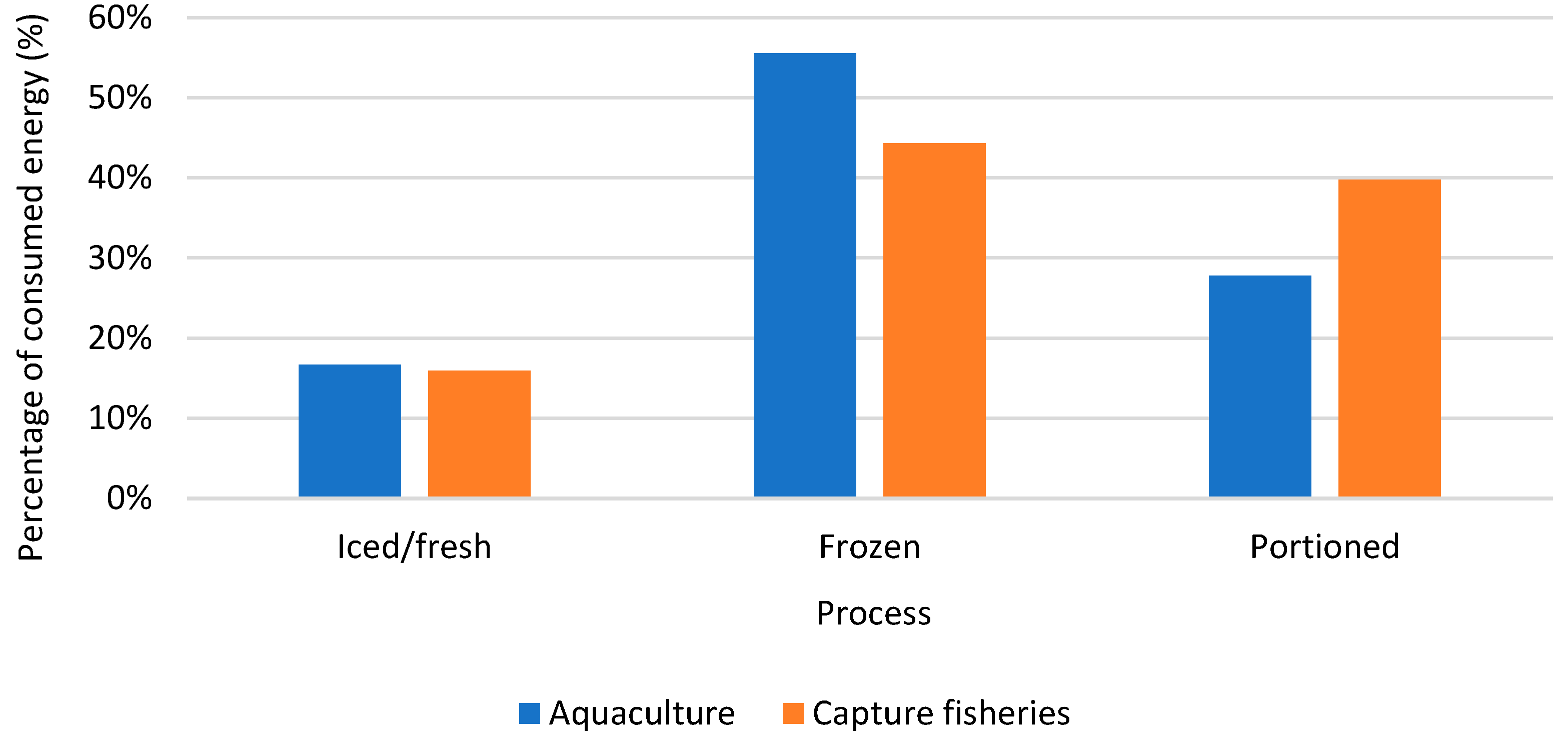


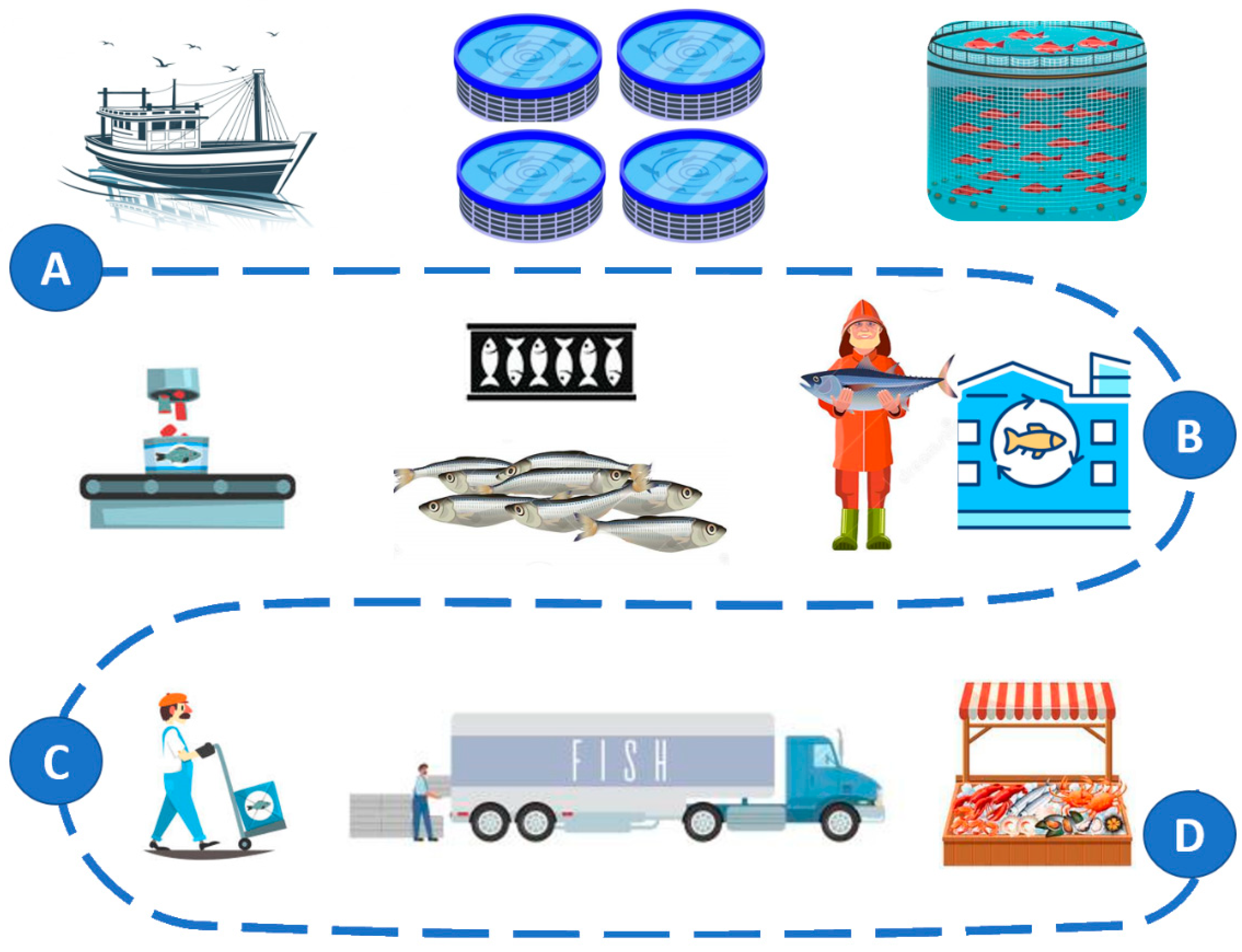



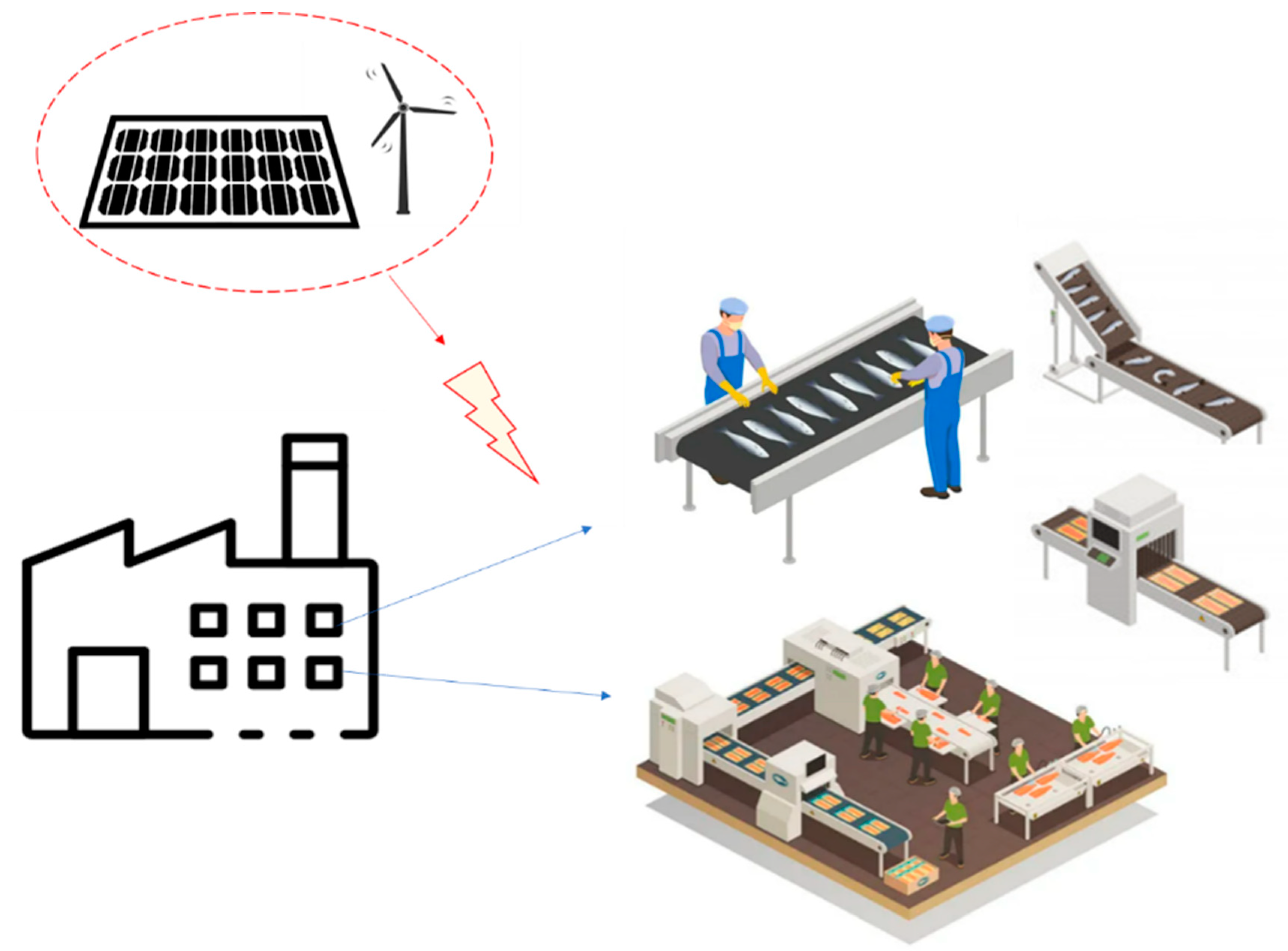
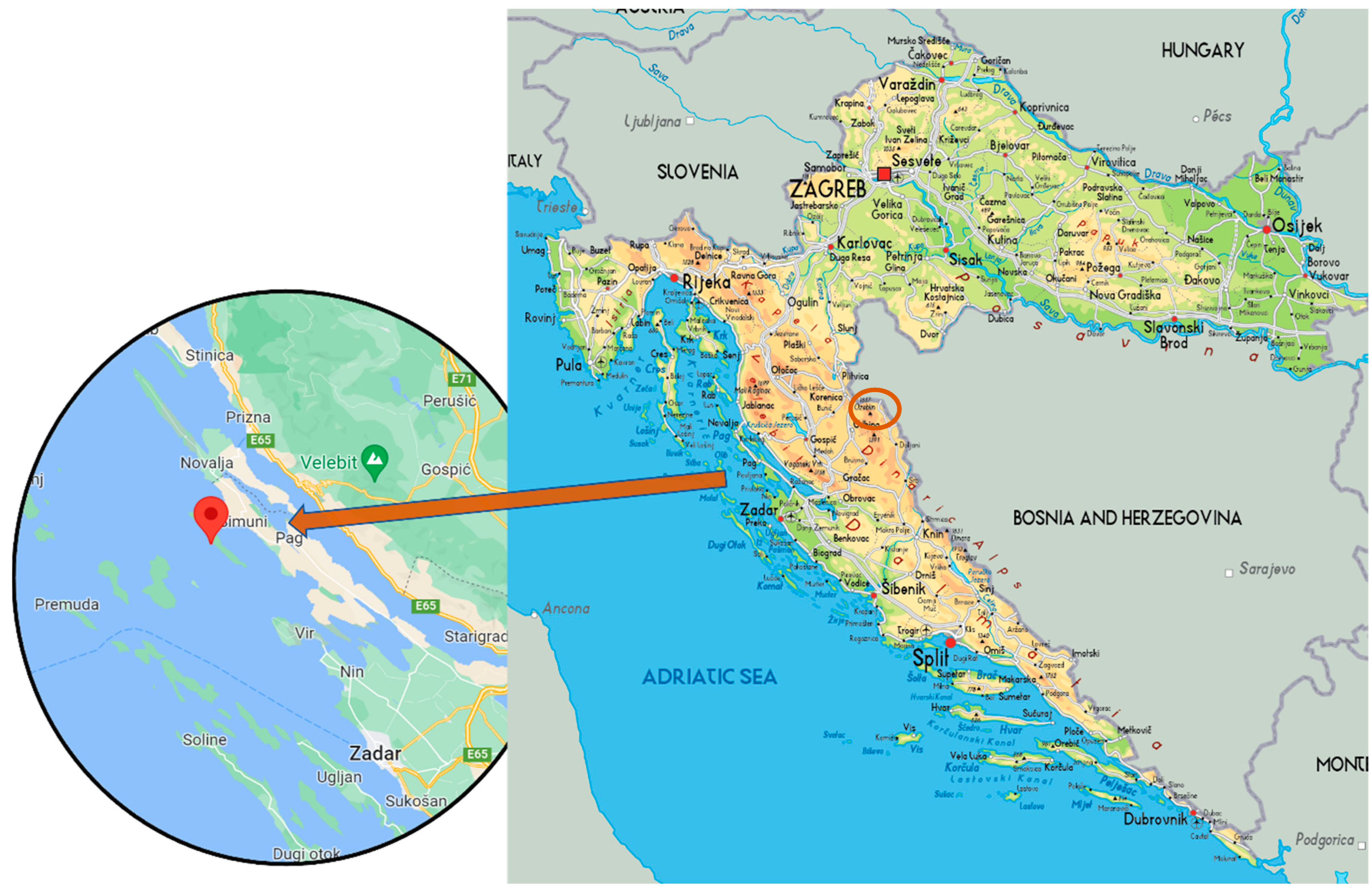

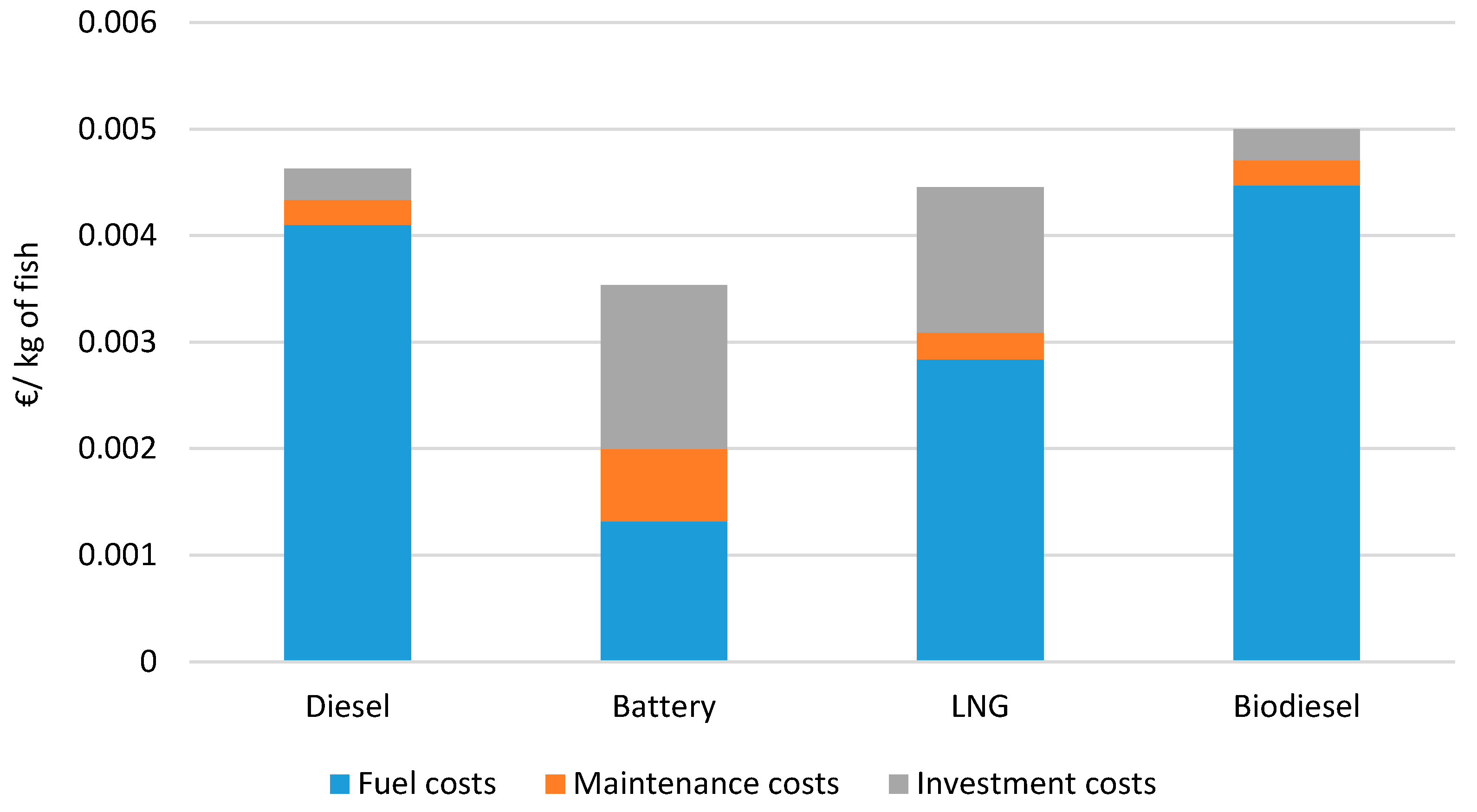

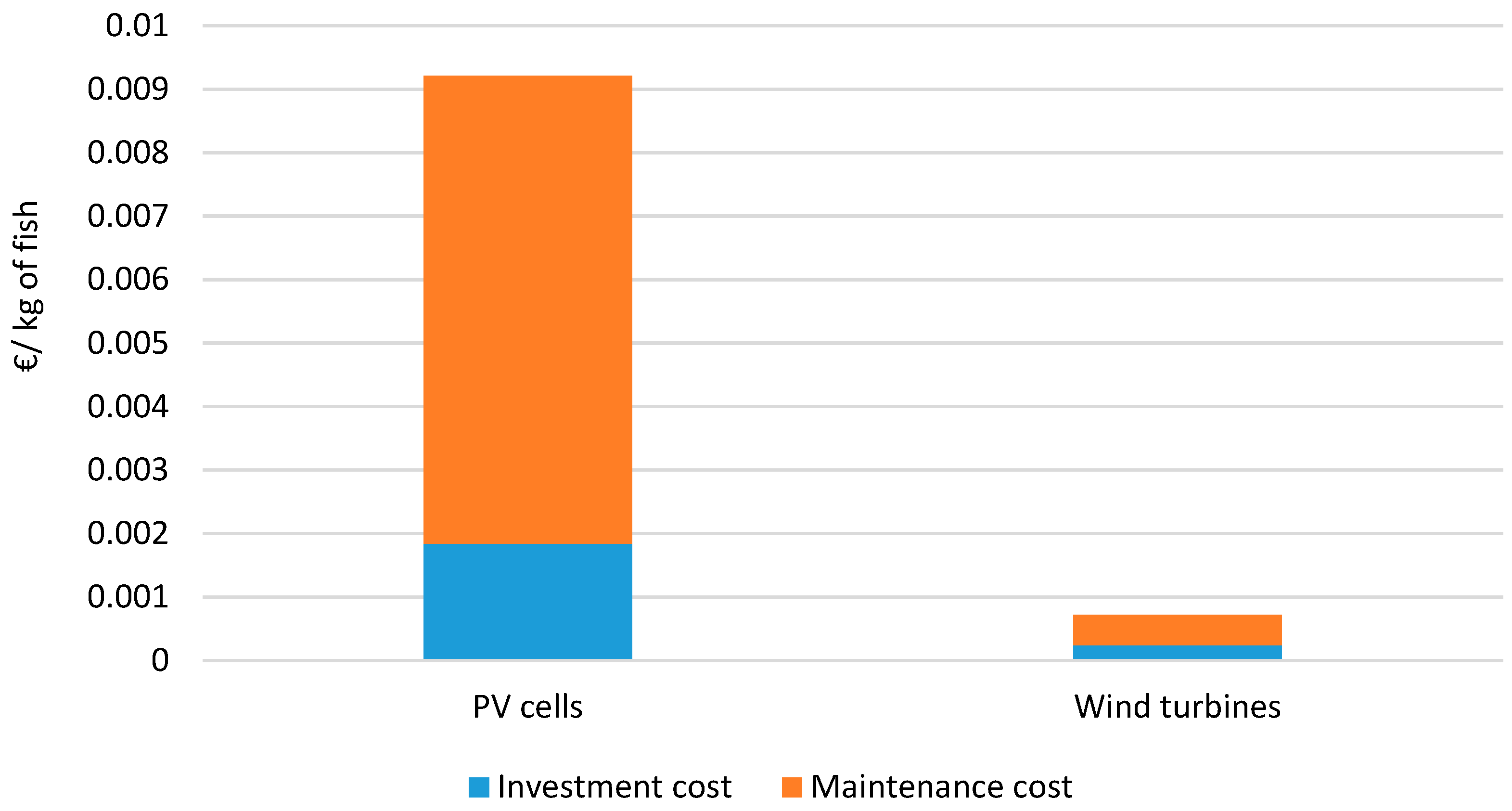

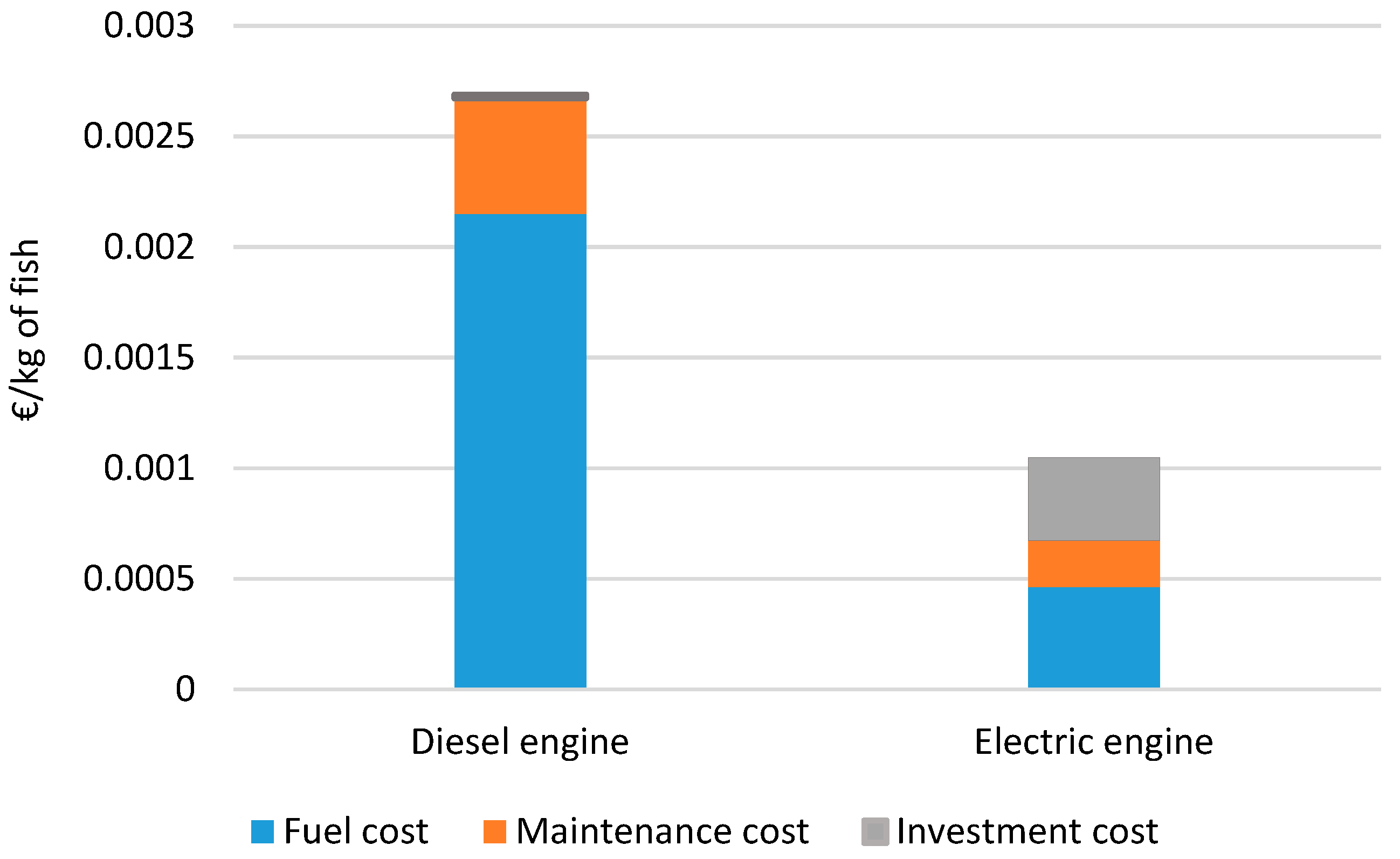
| Sensor | Parameters | Android Application | Web Application | Advantages | Drawbacks |
|---|---|---|---|---|---|
| Celefish [26] | Weather, Fishpond information, Disease, Price fluctuation | n/a | Yes | AI platform, which includes suppliers, fish market, catering enterprises, banks, and insurance companies | Single case study, new areas to explore, how users interact and contribute to sustainability, what are the challenges and obstacles regarding sustainable development, disruption of traditional industries |
| IoT-based aquaculture system [24] | Temperature, pH, Dissolve oxygen, Ammonia | Yes | No | Improve and monitor the quality of water, and aquatic environment more profitable, sustainable, and productive | More parameters for the future, lack of the necessary equipment to maintain proper health for fish, lack of sharing knowledge and informing the fish farmers |
| Artificial Neural Network (ANN) [27] | Salinity, Dissolved oxygen, pH, Temperature | Yes | Yes | A convenient and easily accessible tool to manage aquatic farming | Limitations for specific applications, the lack of a webcam be linked to an image detector in a computer |
| Intelligent fish farm [28] | pH, Dissolved oxygen, EC, Temperature, Ammonia, Nitrite, automatic equipment | Yes | Yes | Measurement and control, feeding, inspection, and harvesting Equipment for an intelligent fish farm is introduced in detail | Education of the farmers, lack of government support, installation and procurement of the equipment |
| Fish Farm Data (eFish Benin, eAquaculture) [29] | For fish diseases classification: Convolutional Neural Network, water quality monitoring, issues detection, alerting, remote pumps controls, and fish diseases detection | Yes | n/a | Arduino Mega, ESP32, wi-fi, and MQTT protocol to collect data from fish farms and send them in real time to smartphones, a digital community for fish farmers to improve their activities | Dependency on wi-fi connectivity and low accuracy in fish diseases classification, improvement of the classification accuracies, deploying the model on ESP32, and integration connectivity media such as SIM Card Router, etc. |
| Blockchain-based fish farm platform [30] | Data integrity for aquaculture | Providing secure storage for large data files and minimizing duplication, approachable interface to provide interaction between the legacy system and the blockchain network, highly secure data and deleting history | The threat of data transmission, lack of authentication, the connection of peer nodes to Local Area Network (LAN), not Wide-Area-Network (WAN) |
| Power System | Diesel Engine Powered |
|---|---|
| FC daily, kg | 250 |
| EC daily, kWh | 1162.79 |
| Equipment consumption daily, kWh | 0.8159 |
| Energy Consumption | Vessel + Feeding Machine | Industry Process | Distribution |
|---|---|---|---|
| kWhdaily | 0.096 | 0.0379 | 0.1428 |
| kWh production process | 70.80 | 27.67 | 104.24 |
| Total consumption in cycle, kWh/kg of fish | 201.91 |
| PV System | Wind Turbine | ||
|---|---|---|---|
| A (m2) | 1000 | Rated capacity (kW) | 20 |
| η (%) | 17 | D (m) | 10 |
| ts (h) | 7 | Swept area (m2) | 78.5 |
| Erad (MJ/m2) | 5825 | Power output–daily (kWh) | 310.4 |
| Power output–daily (kWh) | 107.64 | ||
| Total power output = 418.04 kWh/day |
| Manufacturer | Commercial Name | Maximum Weight | Battery Capacity (kWh) | Range (km) | Energy Consumption (kWh/km) |
|---|---|---|---|---|---|
| Volvo | Fl Electric | 16 t | 100–300 | 100–300 | 1.00 |
Publisher’s Note: MDPI stays neutral with regard to jurisdictional claims in published maps and institutional affiliations. |
© 2022 by the authors. Licensee MDPI, Basel, Switzerland. This article is an open access article distributed under the terms and conditions of the Creative Commons Attribution (CC BY) license (https://creativecommons.org/licenses/by/4.0/).
Share and Cite
Bujas, T.; Koričan, M.; Vukić, M.; Soldo, V.; Vladimir, N.; Fan, A. Review of Energy Consumption by the Fish Farming and Processing Industry in Croatia and the Potential for Zero-Emissions Aquaculture. Energies 2022, 15, 8197. https://doi.org/10.3390/en15218197
Bujas T, Koričan M, Vukić M, Soldo V, Vladimir N, Fan A. Review of Energy Consumption by the Fish Farming and Processing Industry in Croatia and the Potential for Zero-Emissions Aquaculture. Energies. 2022; 15(21):8197. https://doi.org/10.3390/en15218197
Chicago/Turabian StyleBujas, Tena, Marija Koričan, Manuela Vukić, Vladimir Soldo, Nikola Vladimir, and Ailong Fan. 2022. "Review of Energy Consumption by the Fish Farming and Processing Industry in Croatia and the Potential for Zero-Emissions Aquaculture" Energies 15, no. 21: 8197. https://doi.org/10.3390/en15218197
APA StyleBujas, T., Koričan, M., Vukić, M., Soldo, V., Vladimir, N., & Fan, A. (2022). Review of Energy Consumption by the Fish Farming and Processing Industry in Croatia and the Potential for Zero-Emissions Aquaculture. Energies, 15(21), 8197. https://doi.org/10.3390/en15218197








